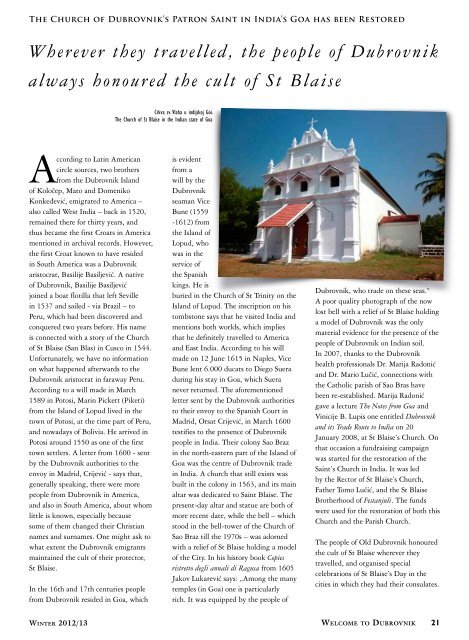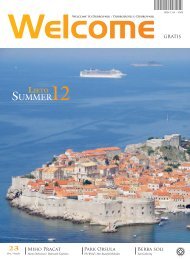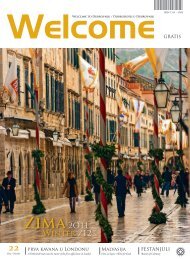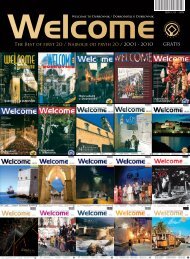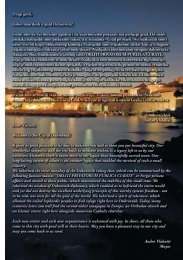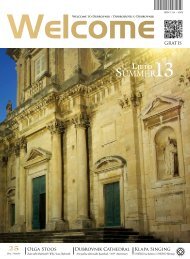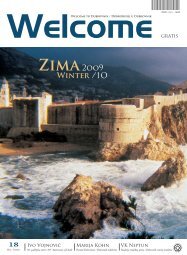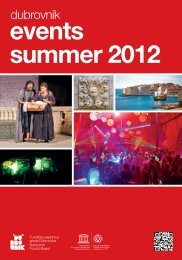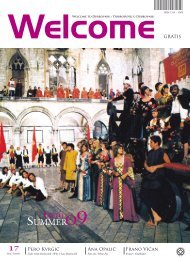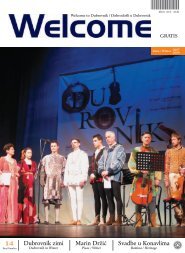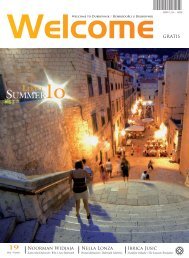24. Welcome to Dubrovnik - TuristiÄka zajednica grada Dubrovnika
24. Welcome to Dubrovnik - TuristiÄka zajednica grada Dubrovnika
24. Welcome to Dubrovnik - TuristiÄka zajednica grada Dubrovnika
Create successful ePaper yourself
Turn your PDF publications into a flip-book with our unique Google optimized e-Paper software.
The Church of <strong>Dubrovnik</strong>’s Patron Saint in India’s Goa has been Res<strong>to</strong>red<br />
Wherever they travelled, the people of <strong>Dubrovnik</strong><br />
always honoured the cult of St Blaise<br />
Crkva sv. Vlaha u indijskoj Goi.<br />
The Church of St Blaise in the Indian state of Goa<br />
According <strong>to</strong> Latin American<br />
circle sources, two brothers<br />
from the <strong>Dubrovnik</strong> Island<br />
of Koločep, Ma<strong>to</strong> and Domeniko<br />
Konkeđević, emigrated <strong>to</strong> America –<br />
also called West India – back in 1520,<br />
remained there for thirty years, and<br />
thus became the first Croats in America<br />
mentioned in archival records. However,<br />
the first Croat known <strong>to</strong> have resided<br />
in South America was a <strong>Dubrovnik</strong><br />
aris<strong>to</strong>crat, Basilije Basiljević. A native<br />
of <strong>Dubrovnik</strong>, Basilije Basiljević<br />
joined a boat flotilla that left Seville<br />
in 1537 and sailed - via Brazil – <strong>to</strong><br />
Peru, which had been discovered and<br />
conquered two years before. His name<br />
is connected with a s<strong>to</strong>ry of the Church<br />
of St Blaise (San Blas) in Cusco in 1544.<br />
Unfortunately, we have no information<br />
on what happened afterwards <strong>to</strong> the<br />
<strong>Dubrovnik</strong> aris<strong>to</strong>crat in faraway Peru.<br />
According <strong>to</strong> a will made in March<br />
1589 in Po<strong>to</strong>si, Marin Pickett (Piketi)<br />
from the Island of Lopud lived in the<br />
<strong>to</strong>wn of Po<strong>to</strong>si, at the time part of Peru,<br />
and nowadays of Bolivia. He arrived in<br />
Po<strong>to</strong>si around 1550 as one of the first<br />
<strong>to</strong>wn settlers. A letter from 1600 - sent<br />
by the <strong>Dubrovnik</strong> authorities <strong>to</strong> the<br />
envoy in Madrid, Crijević - says that,<br />
generally speaking, there were more<br />
people from <strong>Dubrovnik</strong> in America,<br />
and also in South America, about whom<br />
little is known, especially because<br />
some of them changed their Christian<br />
names and surnames. One might ask <strong>to</strong><br />
what extent the <strong>Dubrovnik</strong> emigrants<br />
maintained the cult of their protec<strong>to</strong>r,<br />
St Blaise.<br />
In the 16th and 17th centuries people<br />
from <strong>Dubrovnik</strong> resided in Goa, which<br />
is evident<br />
from a<br />
will by the<br />
<strong>Dubrovnik</strong><br />
seaman Vice<br />
Bune (1559<br />
-1612) from<br />
the Island of<br />
Lopud, who<br />
was in the<br />
service of<br />
the Spanish<br />
kings. He is<br />
buried in the Church of St Trinity on the<br />
Island of Lopud. The inscription on his<br />
<strong>to</strong>mbs<strong>to</strong>ne says that he visited India and<br />
mentions both worlds, which implies<br />
that he definitely travelled <strong>to</strong> America<br />
and East India. According <strong>to</strong> his will<br />
made on 12 June 1615 in Naples, Vice<br />
Bune lent 6.000 ducats <strong>to</strong> Diego Suera<br />
during his stay in Goa, which Suera<br />
never returned. The aforementioned<br />
letter sent by the <strong>Dubrovnik</strong> authorities<br />
<strong>to</strong> their envoy <strong>to</strong> the Spanish Court in<br />
Madrid, Orsat Crijević, in March 1600<br />
testifies <strong>to</strong> the presence of <strong>Dubrovnik</strong><br />
people in India. Their colony Sao Braz<br />
in the north-eastern part of the Island of<br />
Goa was the centre of <strong>Dubrovnik</strong> trade<br />
in India. A church that still exists was<br />
built in the colony in 1563, and its main<br />
altar was dedicated <strong>to</strong> Saint Blaise. The<br />
present-day altar and statue are both of<br />
more recent date, while the bell – which<br />
s<strong>to</strong>od in the bell-<strong>to</strong>wer of the Church of<br />
Sao Braz till the 1970s – was adorned<br />
with a relief of St Blaise holding a model<br />
of the City. In his his<strong>to</strong>ry book Copies<br />
ristret<strong>to</strong> degli annali di Ragusa from 1605<br />
Jakov Lukarević says: „Among the many<br />
temples (in Goa) one is particularly<br />
rich. It was equipped by the people of<br />
<strong>Dubrovnik</strong>, who trade on these seas.“<br />
A poor quality pho<strong>to</strong>graph of the now<br />
lost bell with a relief of St Blaise holding<br />
a model of <strong>Dubrovnik</strong> was the only<br />
material evidence for the presence of the<br />
people of <strong>Dubrovnik</strong> on Indian soil.<br />
In 2007, thanks <strong>to</strong> the <strong>Dubrovnik</strong><br />
health professionals Dr. Marija Radonić<br />
and Dr. Mario Lučić, connections with<br />
the Catholic parish of Sao Bras have<br />
been re-established. Marija Radonić<br />
gave a lecture The Notes from Goa and<br />
Vinicije B. Lupis one entitled <strong>Dubrovnik</strong><br />
and its Trade Route <strong>to</strong> India on 20<br />
January 2008, at St Blaise’s Church. On<br />
that occasion a fundraising campaign<br />
was started for the res<strong>to</strong>ration of the<br />
Saint’s Church in India. It was led<br />
by the Rec<strong>to</strong>r of St Blaise’s Church,<br />
Father Tomo Lučić, and the St Blaise<br />
Brotherhood of Festanjuli. The funds<br />
were used for the res<strong>to</strong>ration of both this<br />
Church and the Parish Church.<br />
The people of Old <strong>Dubrovnik</strong> honoured<br />
the cult of St Blaise wherever they<br />
travelled, and organised special<br />
celebrations of St Blaise’s Day in the<br />
cities in which they had their consulates.<br />
Winter 2012/13<br />
<strong>Welcome</strong> <strong>to</strong> <strong>Dubrovnik</strong> 21


